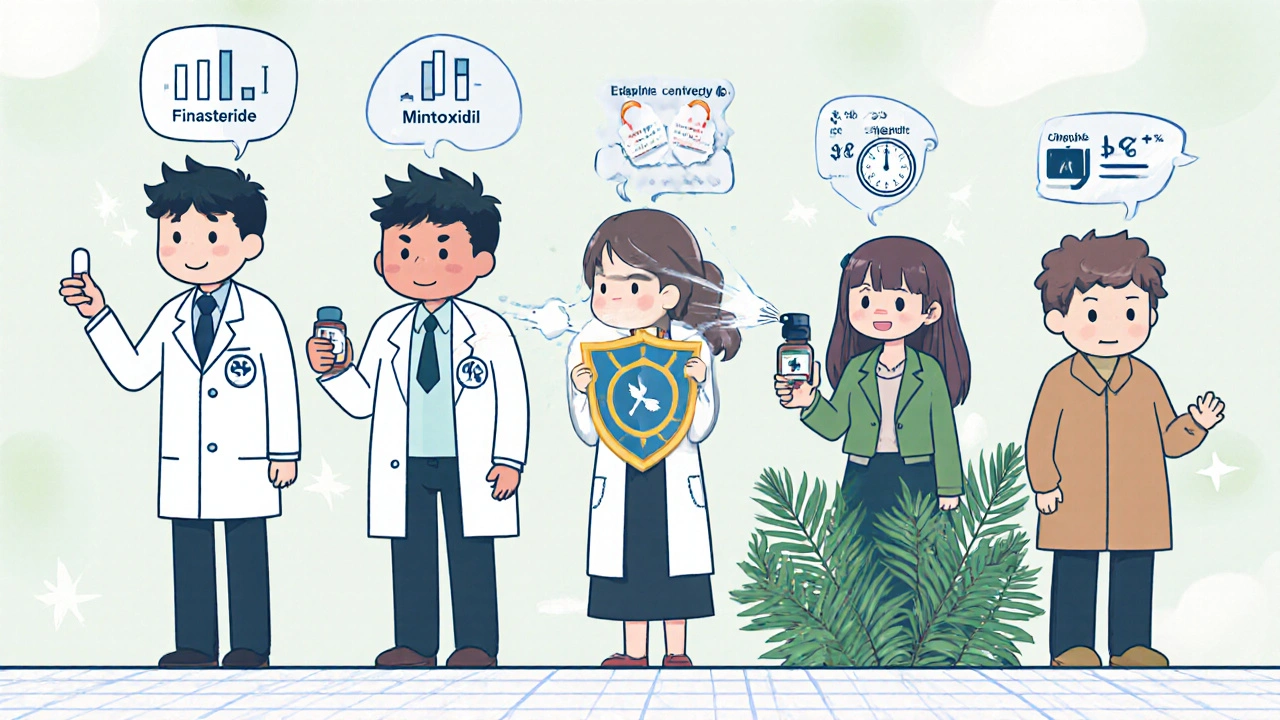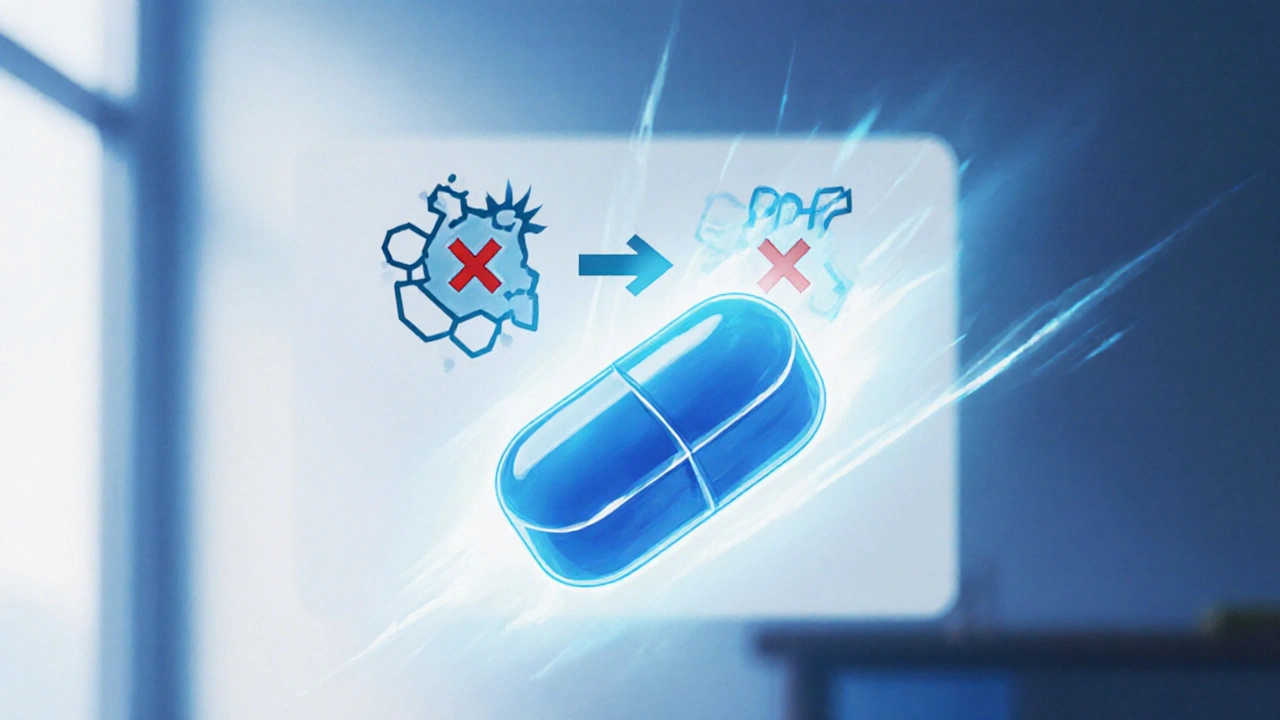Hair Loss & BPH Treatment Finder
Treatment Decision Guide
This tool helps you determine which medication might be most appropriate for your hair loss or BPH needs based on your specific situation.
If you’ve been looking into a pill to slow hair loss or shrink an enlarged prostate, you’ve probably heard the name Finasteride is a synthetic 5‑alpha‑reductase inhibitor that blocks the conversion of testosterone to dihydrotestosterone (DHT). By lowering DHT levels, it helps treat androgenetic alopecia in men and benign prostatic hyperplasia (BPH). Finasteride is sold under brand names like Proscar and Propecia, and sometimes as the generic “Finast.” But is it the right choice for you? Below we compare Finasteride with the most common alternatives, break down the pros and cons, and give you a quick decision guide.
Why a Comparison Matters
Choosing a medication isn’t just about picking the cheapest pill. You need to weigh efficacy, side‑effect profile, cost, and how the drug fits your health goals. Some people prioritize a fast hair‑regrowth result, while others are more concerned about long‑term safety for the prostate. This guide walks you through the key decision criteria so you can match a treatment to your personal needs.
Decision Criteria Checklist
- Target condition: hair loss vs. BPH vs. both
- Mechanism of action: hormone‑based vs. vasodilatory vs. anti‑androgenic
- Onset of effect: weeks, months, or immediate
- Side‑effect risk: sexual dysfunction, hormonal changes, liver impact
- Cost & insurance coverage: generic vs. brand, prescription vs. OTC
- Regulatory status: FDA‑approved, prescription‑only, or supplement
Alternative #1: Dutasteride
Dutasteride is a dual 5‑alpha‑reductase inhibitor that blocks both type I and type II enzymes, making it slightly more potent than Finasteride. It’s sold as Avodart for BPH and is sometimes prescribed off‑label for hair loss.
Key points:
- Effectiveness: Around 30‑40% greater DHT reduction than Finasteride.
- Onset: Noticeable hair‑dense improvement in 3‑6 months.
- Side effects: Similar to Finasteride but a bit higher incidence of sexual dysfunction.
- Cost: Generally higher because it’s brand‑only in the U.S.
Alternative #2: Minoxidil
Minoxidil started life as a blood‑pressure drug, but a topical solution (2% for women, 5% for men) became famous for stimulating hair follicles. It doesn’t affect DHT; it works by increasing blood flow and prolonging the growth phase of hair.
Key points:
- Effectiveness: Works for about 40% of men; best for early‑stage thinning.
- Onset: Visible regrowth within 2‑4 months, but full effect may take a year.
- Side effects: Scalp irritation, unwanted facial hair growth.
- Cost: Low; OTC in most countries.

Alternative #3: Spironolactone
Spironolactone is a potassium‑sparing diuretic that also blocks androgen receptors. It’s primarily used for women with female‑pattern hair loss or hormonal acne.
Key points:
- Effectiveness: Good for women; limited data in men due to feminizing side effects.
- Onset: 3‑6 months for noticeable hair‑density change.
- Side effects: Breast tenderness, menstrual irregularities, hyperkalemia.
- Cost: Generic, inexpensive.
Alternative #4: Saw Palmetto
Saw Palmetto is a botanical extract often marketed as a natural DHT blocker. The evidence is mixed, but many users appreciate its OTC availability.
Key points:
- Effectiveness: Small studies show modest DHT reduction; results vary.
- Onset: Several months, if any effect is seen.
- Side effects: Generally mild-upset stomach, occasional headache.
- Cost: Low; found in most health‑food stores.
Head‑to‑Head Comparison Table
| Feature | Finasteride | Dutasteride | Minoxidil (topical) | Spironolactone | Saw Palmetto |
|---|---|---|---|---|---|
| Primary use | Male‑pattern hair loss, BPH | BPH, off‑label hair loss | Hair regrowth (topical) | Female‑pattern hair loss, acne | Natural DHT reduction |
| Mechanism | 5‑alpha‑reductase type II inhibition | Dual type I & II inhibition | Vasodilation, follicle stimulation | Androgen‑receptor blockade | Plant‑based enzyme inhibition |
| Prescription? | Yes (generic) | Yes (brand) | No (OTC) | Yes (prescription) | No (OTC) |
| Typical onset | 3‑6 months | 3‑6 months (slightly faster) | 2‑4 months (full effect 12 months) | 3‑6 months | 4‑6 months (if effective) |
| Key side effects | Sexual dysfunction, breast tenderness | Higher rate of sexual side effects | Scalp irritation, unwanted hair | Gynecomastia, electrolyte imbalance | Mild GI upset |
| Cost (US) | $0.20‑$0.40 per tablet | $1.00‑$1.50 per tablet | $20‑$40 per 60‑ml bottle | $0.15‑$0.30 per tablet | $15‑$30 per 60‑caps pack |
Pros & Cons Summary
Finasteride shines for men who need a proven, prescription‑only option for both hair loss and BPH. Its major drawback is the risk of sexual side effects, which affect roughly 2‑5% of users.
Dutasteride offers stronger DHT suppression, potentially better results for stubborn cases, but the higher price and similar side‑effect profile make it a second‑line choice.
Minoxidil is the go‑to for those who prefer a non‑systemic, over‑the‑counter solution. It works for a wider audience, including women, yet it requires daily application and may cause scalp irritation.
Spironolactone is ideal for women with hormone‑driven thinning, but men should avoid it because of feminizing effects.
Saw Palmetto appeals to the “natural‑only” crowd, but the evidence is weak and you shouldn’t rely on it as a sole therapy.

How to Choose the Right Option
- Identify your primary goal. If BPH symptoms dominate, Finasteride or Dutasteride are the only FDA‑approved oral choices.
- Consider gender. Women typically avoid Finasteride and Dutasteride; Spironolactone or Minoxidil are safer.
- Assess tolerance for side effects. If sexual function is a deal‑breaker, start with Minoxidil or Saw Palmetto before moving to hormonal blockers.
- Look at cost and insurance. Generic Finasteride is often covered; Minoxidil and Saw Palmetto are paid out‑of‑pocket.
- Talk to a clinician. A doctor can run a simple blood test to check baseline hormone levels and recommend the safest regimen.
Understanding Side Effects in Depth
All oral DHT blockers share a core side‑effect category: sexual dysfunction. This includes decreased libido, erectile difficulty, and reduced semen volume. Studies from 2023‑2024 show that about 2% of men experience persistent symptoms after stopping the drug, a condition sometimes called post‑finasteride syndrome. While controversial, the risk is real enough to discuss with a pharmacist.
Other hormone‑related issues can include breast tenderness or mild gynecomastia. Liver function tests are rarely affected, but patients with pre‑existing liver disease should have baseline labs.
Topical Minoxidil avoids systemic hormone changes but can cause localized itching, scaling, or a temporary shedding phase as new hairs push out old ones. Spironolactide’s biggest safety concern is hyperkalemia, especially in older adults taking other potassium‑sparing meds.
If you notice any side effect, don’t quit abruptly. Tapering off under medical supervision reduces the chance of a rebound flare, especially for BPH symptoms.
Real‑World Stories
John, 42, tried Finasteride for three years and saw his receding hairline stabilize. He did report occasional night‑time libido dips, which vanished after a short drug holiday.
Maria, 28, used Minoxidil on a patchy crown. After six months, the hair density improved enough that she stopped using the product and kept the new growth.
Sam, 58, switched from Finasteride to Dutasteride after his prostate specific antigen (PSA) level rose. The new medication halved his nighttime bathroom trips, but he experienced a brief period of decreased libido that settled after two months.
Bottom Line
When you line up Finasteride against the most common alternatives, the picture becomes clear: it’s the most evidence‑backed oral option for men dealing with both hair loss and BPH, but it carries a measurable sexual‑side‑effect risk. If you’re a woman, a man who can’t tolerate those side effects, or simply prefer a non‑prescription route, Minoxidil, Spironolactone (for women), or a carefully chosen supplement like Saw Palmetto may be a better fit.
Whatever you decide, a short conversation with a healthcare provider can personalize the choice, set realistic expectations, and keep you safe.
Can women take Finasteride for hair loss?
Finasteride is not FDA‑approved for women, especially those who are pregnant or could become pregnant, because it may affect fetal development. Women looking for a prescription option often turn to Spironolactone or low‑dose oral Minoxidil under a doctor’s supervision.
How long does it take to see results with Finasteride?
Most men notice a slowdown in hair loss within three months, but measurable regrowth typically appears after six to twelve months of daily dosing.
Is Saw Palmetto a reliable alternative to Finasteride?
The research is mixed. Some small trials show modest DHT reduction, but large‑scale studies haven’t confirmed the same efficacy as prescription blockers. It may help as a supplement, but don’t rely on it alone if you need significant results.
Can I use Minoxidil and Finasteride together?
Yes. Many dermatologists prescribe both: Finasteride works systemically to lower DHT, while Minoxidil promotes follicle activity locally. Combining them can boost overall hair‑growth outcomes, but follow the dosing instructions for each.
What should I do if I experience sexual side effects?
First, talk to your prescribing doctor. They may suggest a dose reduction, a drug holiday, or switching to Dutasteride’s lower‑dose formulation. Never stop abruptly without medical guidance, especially if you’re taking the drug for BPH.


Kathrynne Krause
October 21, 2025 AT 15:07Alright folks, let’s cut through the jargon and get to the heart of the matter – Finasteride is the seasoned veteran in the hair‑loss arena, but the alternatives each bring their own flavor to the table. If you’re after a prescription‑grade, proven track record, Finasteride’s your go‑to, but if you’re wary of the infamous side‑effects, there’s a whole pantry of options to explore. Think of it like a buffet: you pick the dish that satisfies your cravings without giving you a food‑coma.
Chirag Muthoo
October 28, 2025 AT 01:40In consideration of the preceding observations, it is prudent to evaluate the pharmacodynamic profile of each agent. Finasteride exhibits type II inhibition, whereas dutasteride encompasses both type I and II, thereby achieving a marginally higher reduction in dihydrotestosterone levels. The clinical implications of this distinction should be weighed against cost and tolerability.
erica fenty
November 3, 2025 AT 13:14TL;DR: Finasteride = proven; Dutasteride = stronger; Minoxidil = topical; Spironolactone = women; Saw Palmetto = supplement; choose based on target, side‑effects, and budget!!!
Jasmina Redzepovic
November 10, 2025 AT 00:47Listen up, Americans! The truth is that the pharma giants push Finasteride because it lines their pockets, but the real power move is to go full‑on with Dutasteride if you can stomach the cost. And don’t even get me started on those herbal “solutions” – they’re nothing but snake‑oil for the gullible masses.
Kimberly Lloyd
November 16, 2025 AT 12:20From a philosophical standpoint, choosing a treatment is an act of self‑determination. One must contemplate the temporal horizon of hair growth versus the ethical weight of potential side effects. In essence, the decision reflects our values about bodily autonomy and the willingness to embrace imperfection.
John Price
November 22, 2025 AT 23:54That makes sense. I’d add that tracking progress with photos every month helps keep expectations realistic.
Nick M
November 29, 2025 AT 11:27Never trust big pharma.
Ericka Suarez
December 5, 2025 AT 23:00Okay, let me break it down for the rest of you who are still lost in the sea of meds. First, Finasteride is the OG, the original gangster of DHT blockers. It works by targeting the type II enzyme, which is enough for most men to see a slowdown in hair loss after a few months. The side‑effects? Yep, there’s the usual sexual dip, a little breast tenderness – nothing that can’t be monitored with a doc’s help.
Now, Dutasteride is the newer kid on the block. It shuts down both type I and II enzymes, so you get a deeper DHT cut. That means better odds for stubborn cases, but also a higher chance of those same sexual side‑effects – think of it as a double‑edged sword.
On the topical side, Minoxidil is the classic over‑the‑counter play. You slather it on, and it boosts blood flow to the follicles, extending the growth phase. No hormones, no systemic effects, but you have to be diligent – daily application for at least a year if you want to see the full payoff.
Spironolactone is a different beast entirely, mainly for women. It blocks androgen receptors and can help with hormonal hair loss, but men usually stay away because of the feminizing impact.
Saw Palmetto, the “natural” route, is a mixed bag. Some studies show a modest DHT drop, but many users report nothing. It’s cheap and safe, so it’s worth a try if you’re looking for a low‑risk supplement, but don’t bet the house on it.
Bottom line: If you’re a guy with both BPH and hair loss, Finasteride or Dutasteride are the only FDA‑approved oral options. If you’re scared of systemic side‑effects, go topical with Minoxidil or try Saw Palmetto as a side‑kick. Always talk to a professional before swapping meds – the last thing you want is a surprise in the bedroom.
parbat parbatzapada
December 12, 2025 AT 10:34Yo, the pharma lizards got us all doped up with finasteride while they hide the real cure in the shadows. Did ya hear bout the nano‑gravity serum? It's on the deep web and it resets hair follicles without any DHT mess. Look out for the micro‑chip in the bottle, they track you!
Casey Cloud
December 18, 2025 AT 22:07Here’s a quick practical tip: when you start any oral DHT blocker, get baseline labs – testosterone, PSA, liver enzymes – then repeat every 6 months. This keeps you from surprise spikes and lets your doc adjust dosage before side effects become a real problem.